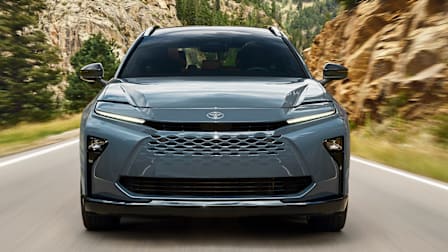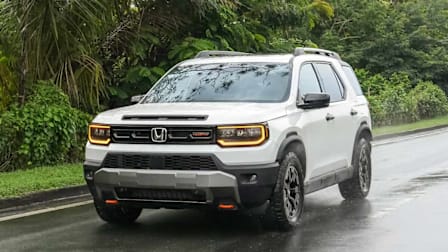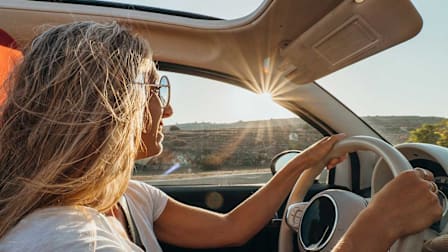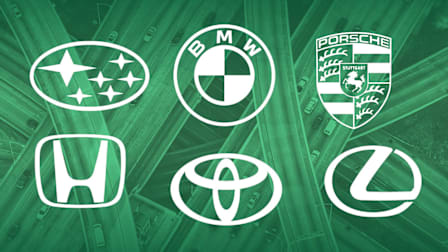The Safest Cars You Can Buy Right Now
We share the models built to protect you with the advances shown here

Every year, around 40,000 people are killed and over 2 million are injured on U.S. roads, according to the National Highway Traffic Safety Administration. But there’s some good news: New cars are better than ever at keeping their occupants—and even people outside the car—safe. “The safest cars don’t just protect passengers in a crash. They may avoid a crash in the first place,” says Emily Thomas, PhD, manager of safety at CR’s Auto Test Center. “They may also lower risks to pedestrians and people in other cars.”
Cars and Features to Help You Stay Safe on the Road
CR’s experts spotlight the safest new and used cars.
What Keeps Cars From Crashing
Advanced driver assistance systems (ADAS) help avoid crashes by sounding alarms and even engaging the brakes to avoid or lessen the impact of a collision when drivers don’t respond in a high-risk situation. Three ADAS features you may have heard of—automatic emergency braking (AEB), blind spot warning (BSW), and rear cross traffic warning (RCTW)—are effective at preventing crashes, according to studies from the Insurance Institute for Highway Safety (IIHS) and the Highway Loss Data Institute (HLDI).
Apart from safety technology, the laws of physics and a car’s engineering also determine how easy it is for a driver to avoid a crash. For example, heavier vehicles tend to take longer to stop and taller vehicles tend to be harder to control in turns. On the other hand, cars with more advanced suspensions or better-tuned stability control make it easier to swerve around obstacles, Fisher says.
What does all of that mean when you’re shopping for a new car? You can refer to the scores that vehicles earn in CR’s braking and crash avoidance maneuver tests to choose a safer vehicle. “Vehicles that excel in CR’s braking tests are more likely to give a driver a chance to stop in time, and vehicles that make it through CR’s crash avoidance maneuver test at a high speed without losing control can help drivers evade obstacles,” Fisher says.
Finally, a vehicle with confusing controls is more likely to require a driver to take their eyes off the road and hands off the wheel. For example, some vehicles force drivers to use a finicky touchscreen to change the temperature or adjust the radio volume, which can be dangerously distracting while driving.
See the safest cars, according to IIHS.
What Protects the People Inside
When all else fails and a crash happens, the safest cars protect you in several ways, Thomas says. “A car’s structure has ‘crumple zones’ that are designed to be crushed in a crash, absorbing the impact and minimizing the crash forces on occupants,” she says. “Then there are airbags and seat belts to keep occupants in place so that they don’t strike the hard surfaces of the vehicle interior. And the integrity of the vehicle’s structure prevents intrusion of your own vehicle—or another—into the passenger compartment.”
To find out how well a vehicle will protect you in a crash, you can start by looking at its NHTSA crash-test ratings, which use a scale of one to five stars, printed on the window sticker of every new car. You can learn even more by checking the safety rating provided by the insurance industry-funded IIHS, says Jennifer Stockburger, director of operations at CR’s Auto Test Center. While NHTSA’s rating criteria have remained the same for over a decade, the IIHS tests have become tougher in recent years. “The IIHS tests challenge vehicles in new ways that better replicate real-world crashes,” Stockburger says. For example, as SUVs and pickups grew in popularity, the IIHS redesigned its side-impact test in 2021 to better predict how a vehicle would fare if it got hit by one of those taller models. The organization has also added rear-seat and passenger-side crash tests in recent years, and CR factors IIHS test results into a vehicle’s Overall Score.
As a result, most automakers have improved the crash safety of their vehicles to meet those more stringent testing standards, Stockburger says, and cars today are much safer than they were just a decade ago.
In addition to crash-test results that range from Poor to Good, the IIHS also awards the Top Safety Pick and Top Safety Pick Plus designations to vehicles that excel across crash testing and crash avoidance measures. We’ve highlighted those vehicles in our list of the safest top-rated cars. The criteria for those designations get tougher every year as well, raising the bar for all cars. For example, the Dodge Durango below got a Top Safety Pick award when it was first introduced in 2011 but lost it for 2015 after the IIHS added stricter test criteria.
Which Car Protects You the Most?
The images below show two SUVs after the IIHS small-overlap front crash test, which replicates hitting a tree, a telephone pole, or the corner of an oncoming vehicle. While both of these midsized SUVs have met government safety standards, the results illustrate how some vehicles can offer better protection in a crash.
More Protection: Mazda CX-90
The CX-90, which was introduced as a new model in 2023, earned a Good score (the highest) in the IIHS test. It maintained a “survival space” that kept the crash-test dummy from being crushed and prevented chest, hip, leg, and foot injuries. The Mazda’s airbags protected the dummy’s head as well.
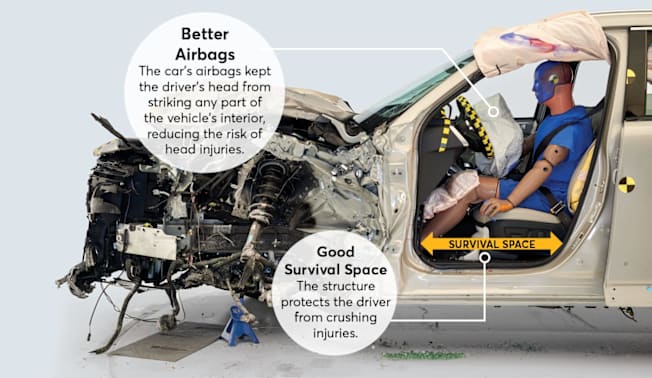
Less Protection: Dodge Durango
The Durango got its last major update in 2011. It earned a Marginal score for the driver side, which is the next-to-lowest rating. It didn’t maintain an adequate survival space for the driver, and parts of the vehicle intruded into the cabin, increasing the risk of leg, foot, and hip injuries for the driver.
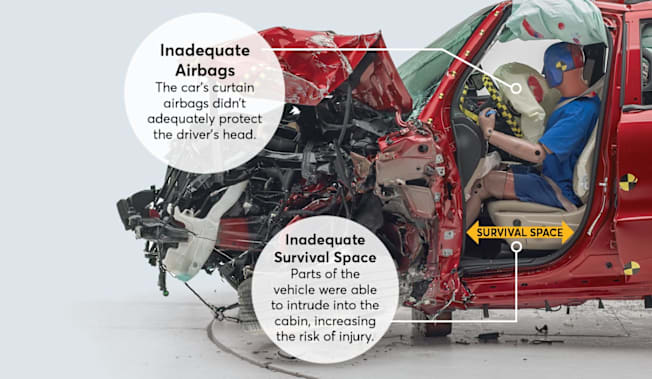
What Protects the People Outside
Car safety isn’t just about protecting you and your passengers. It’s also important to reduce the risk of injury for everyone on the road, including pedestrians, cyclists, and occupants of other vehicles. According to the Governors Highway Safety Association (GHSA), drivers struck and killed 7,318 people in the U.S. in 2023—only a small decrease from 2022 when 7,522 people in the U.S. were killed, marking a 40-year high in pedestrian fatalities.
What keeps people outside your auto safer? First, the type of vehicle you drive makes a difference. Research from the GHSA, the University of Illinois Springfield, and the IIHS shows that tall and boxy vehicles such as SUVs and pickup trucks pose an outsized danger to pedestrians and drivers of smaller vehicles because their front ends obscure visibility and are more likely to cause injuries to those they hit. Shorter and less-boxy vehicles pose less of a risk.
How much a vehicle weighs is also important. Although heavier vehicles tend to fare better in a collision than lighter ones because they can absorb more crash forces, heavy vehicles can pose greater risks to others on the road. “Large vehicles tend to be harder to handle in an emergency and need more distance to stop,” Thomas says. “They’re also more likely to cause injuries to pedestrians and occupants of a smaller vehicle in a crash.”
That’s why our list of the safest vehicles includes only those with good scores in our handling and braking distance tests, and standard AEB with pedestrian detection. That’s a feature that reduces pedestrian-injury crash risk by 30 percent, according to an IIHS study. This and other crash-prevention technology, such as standard highway-speed AEB, BSW, and RCTW, can help make roads safer for everyone, says William Wallace, associate director of safety policy at CR, but only if it’s universally available. Currently, most vehicles have both highway-speed AEB and AEB that can also detect pedestrians, but some heavy vehicles don’t come standard with those features.
“Just like seat belts, every new vehicle should be required to come standard with the technology that is proved to save lives, particularly AEB,” Wallace says.
9 Safe Top-Rated Cars
These CR Recommended vehicles are examples of some of the safest 2025 models. They excel in crash avoidance by earning good scores in our braking performance, emergency handling, rollaway protection, and usability tests, and also have standard highway-speed AEB, AEB with pedestrian detection, blind spot warning, and rear cross traffic warning. And they have those protective features in every trim level, not just the priciest ones.
As part of our ratings, we’ve eliminated vehicles that score below four stars in NHTSA’s crash tests and those with scores of Marginal or Poor, the second-lowest and lowest scores, respectively, in any of the IIHS original crash tests.
All vehicles on this list meet the same safety criteria and are ordered by Overall Score, starting with the highest score.
Click on the model names below for full performance, safety, reliability, and pricing details.
Recommended Safety Systems
Blind Spot Warning (BSW)
Using sensors, it detects vehicles in adjacent lanes and alerts drivers to their presence, reducing lane-change crashes with injuries by 23 percent, according to data from the IIHS and HLDI.
Highway-Speed Automatic Emergency Braking (AEB)
Some AEB systems work at highway speeds—typically above 55 mph. According to IIHS data, the technology cuts rear-end collisions by up to 50 percent when a vehicle is also equipped with forward collision warning (FCW), which alerts drivers to an imminent crash.
Rear Cross Traffic Warning (RCTW)
When the car is in Reverse, it uses sensors to detect vehicles (and often pedestrians) approaching from either side and warns the driver of their presence. According to the IIHS, RCTW cuts this kind of crash by 22 percent.
Automatic Crash Notification (ACN)
Automatically alerts first responders if an airbag deploys or sensors detect a crash. NHTSA estimates this feature could save more than 700 lives a year.
Learn more about car safety features and how they work.
Where Are the Subarus?
@consumerreports Safety is critical. See our list of the safest cars you can buy right now through the link in our bio. #cartiktok #cartok #carsafety
♬ original sound - Consumer Reports
Editor’s Note: A version of this article also appeared in the October 2024 issue of Consumer Reports magazine.

















